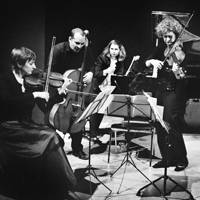Mondrian Ensemble

Genre: Classical Music
There is a growing gap between the New Music industry with its compulsive devotion to world premières on the one hand, and the established Classical scene that primarily embraces music from Bach to Stravinsky on the other hand. It is this gap repertoire to which the Mondrian Ensemble has been committed since 2000 and, above and beyond, it endeavours to link up different historical eras, regardless of whatever chasms might have to be crossed to achieve it. The Mondrian's commitment to both new and newest music is thus just as important as its engagement to the Classical-Romantic repertoire. It takes particular pleasure in experiments that illuminate cross-connections that one would not notice at first glance - such as those that exist between Liszt's late oeuvre and drone improvisation, or between Franz Schubert's sense of temporal organisation and that of Morton Feldman. Shortly after its foundation in 2000, the Mondrian Ensemble won the Nicati Competition for the interpretation of contemporary music, and in 2003 the third prize in a chamber music competition organized by the Migros-Genossenschafts-Bund. There followed debuts at the Zurich Tonhalle (2003), at the Lucerne Festival (2005), at the Musikverein in Vienna (2006) and the Wigmore Hall in London (2007 - Swiss Ambassador Award) as well as participation in many festivals and tours. Most recently, the Mondrian Ensemble was awarded a Working Year Scholarship by the City of Zurich. Numerous composers have written works for the Mondrian Ensemble, which it has endeavoured to keep in its repertoire beyond their first performances. These include Dieter Ammann's "Gehörte Form - Hommages" (performed around forty times) and works by Wanja Aloe, Jürg Frey, Rudolf Kelterborn, Detlev Müller-Siemens, Roland Moser, Felix Profos, Michel Roth, Martin Jaggi (long-time cellist of the Ensemble) and many others. In 2004 the Ensemble was featured in a portrait CD by Grammont; in 2007 the Ensemble made recordings for the Grammont portrait CD of Felix Profos and in 2010 for a portrait CD of Dieter Ammann. The portrait CD of Detlev Müller-Siemens recorded by WERGO in 2013 will be followed by a CD by NEOS in 2014 featuring music by Rudolf Kelterborn, Roland Moser and Michel Roth.
Members:
Petra Ackermann (viola)
Tamriko Kordzaia (piano)
Ivana Pristasova (violin)
Karolina Öhman (violoncello)
Repertory
Wanja Aloe: soleil noir
Ludwig van Beethoven: Streichtrio, op. 9 Nr. 3
Johannes Brahms: Klaviertrio Nr. 1, op. 8
Morton Feldman: Piano, Violin, Viola, Cello
Martin Jaggi: Schebka für Klavierquintett (mit Kontrabass)
Martin Jaggi: ".. à vois si basse que nul ne l'entend jamais" für Flöte und Klaviertrio
Philipp Jarnach: Drei Rhapsodien, op. 20: Kammerduette für Violine und Klavier
Isabel Klaus: must
Max Reger: Klaviertrio e-moll, op.102
Max Reger: erschöpfung für Streichtrio
Nikolaj Roslawez: Klaviertrio Nr. 2
Nikolaj Roslawez: Klaviertrio Nr. 3
Giacinto Scelsi: Trio à cordes
Alfred Schnittke: Klavierquartett
Dmitri Schostakovitsch: Sonate, op. 134 für Violine und Klavier
Dmitri Schostakovitsch: Klaviertrio Nr. 2, op. 67
Robert Schumann: Klaviertrio Nr. 3, op. 110
Arnold Schönberg: Streichtrio op.45
Lothar Voigtländer: Variations sur un mode sentimental für Klaviertrio
Aloe Wanja: was es war Streichtrio und Midi-Keyboard
Anton Webern: Streichtrio op. 20
Ivan Wyschnegradsky: Trio à cordes op. 53
Iannis Xenakis: Ikhoor für Streichtrio
Iannis Xenakis: Mikka für Violine solo
Iannis Xenakis: Dhipli Zyia für Violine und Violoncello
Isang Yung: Klaviertrio
Bernd Alois Zimmermann: Intercomunicazione für Violoncello und Klavier
Discography
Jürg Frey (Musiques Suisses Nr. MGB CTS-M 144, 2014)
Frey, Jürg: Architektur der Empfindungen (2013)
Frey, Jürg: Mémoire, horizon (2013-2014)
Interpreters:
Mondrian EnsembleWorks:
Frey, Jürg: Extended Circular Music 1-7 (2011-2014)Frey, Jürg: Architektur der Empfindungen (2013)
Frey, Jürg: Mémoire, horizon (2013-2014)
Info: www.fonoteca.ch
Dieter Ammann (Grammont Porträt Nr. MGB CTS-M 124, 2010)
Mondrian Ensemble
Amar Quartett
Ammann, Dieter: Geborstener Satz (2003)
Ammann, Dieter: Après le silence (2005)
Ammann, Dieter: Streichquartett Nr. 2 "Distanzenquartett" (2009)
Interpreters:
Zappa, DariaMondrian Ensemble
Amar Quartett
Works:
Ammann, Dieter: Gehörte Form - Hommages (1998)Ammann, Dieter: Geborstener Satz (2003)
Ammann, Dieter: Après le silence (2005)
Ammann, Dieter: Streichquartett Nr. 2 "Distanzenquartett" (2009)
Felix Profos - Porträt (Grammont Portrait Nr. MGBCTS-M 109, 2007)
Mondrian Ensemble
Profos, Felix: pink chips (2000)
Profos, Felix: Zwang (2000)
Profos, Felix: PAI (2004)
Profos, Felix: Septett (2005)
Interpreters:
Kissóczy, MarcMondrian Ensemble
Works:
Profos, Felix: come to Daddy (2000)Profos, Felix: pink chips (2000)
Profos, Felix: Zwang (2000)
Profos, Felix: PAI (2004)
Profos, Felix: Septett (2005)
Info: www.fonoteca.ch
Mondrian Ensemble (Grammont Porträt Nr. 88, 2004)
Roth, Michel: Verinnerung (2001-2002)
Jaggi, Martin: Schebka (2001)
With more works of: Iannis Xenakis, Giacinto Scelsi, Martin Jaggi
Interpreters:
Mondrian EnsembleWorks:
Ammann, Dieter: Gehörte Form - Hommages (1998)Roth, Michel: Verinnerung (2001-2002)
Jaggi, Martin: Schebka (2001)
With more works of: Iannis Xenakis, Giacinto Scelsi, Martin Jaggi
Info: www.fonoteca.ch
Last updated: 2020-10-06 14:35:50
